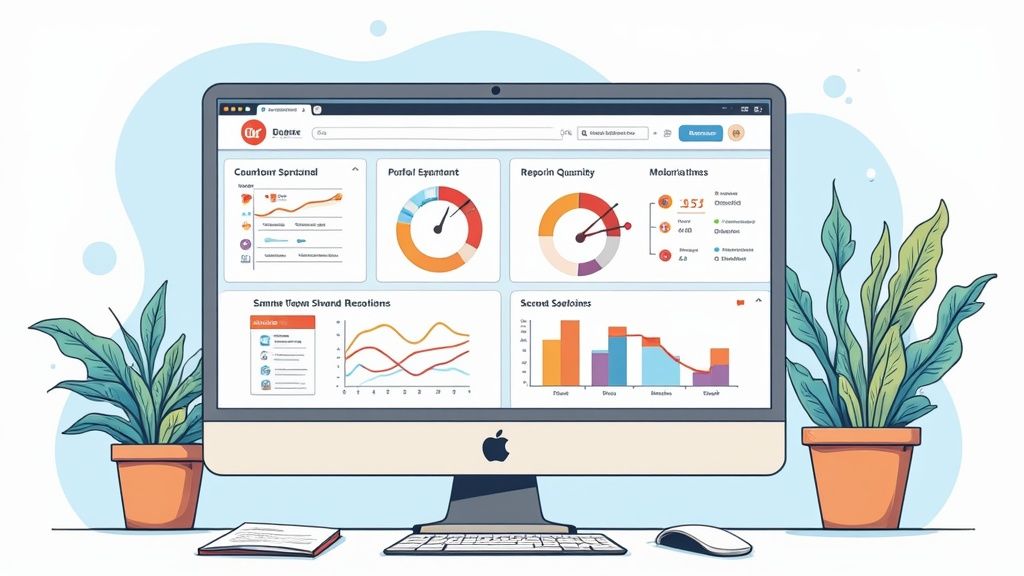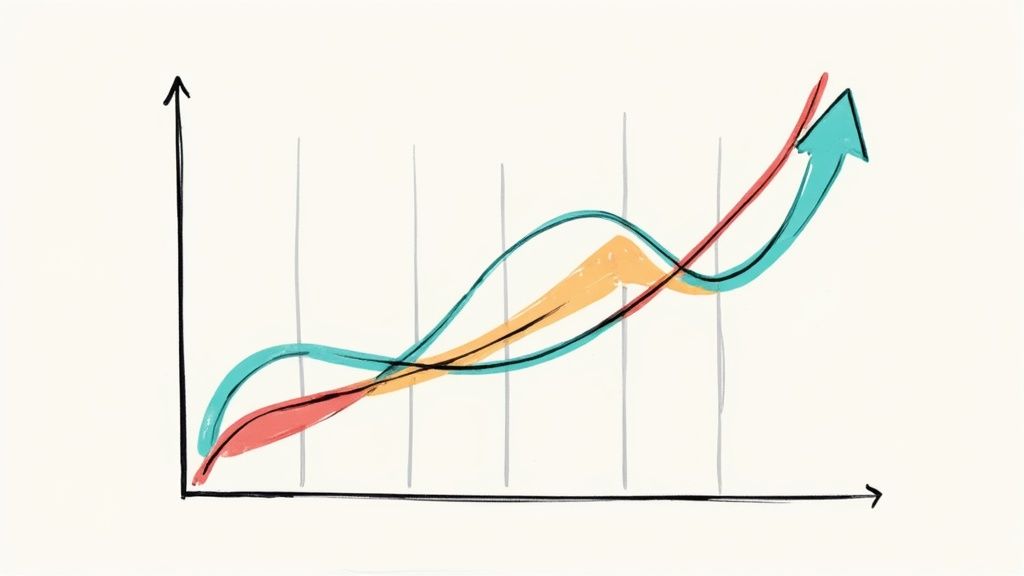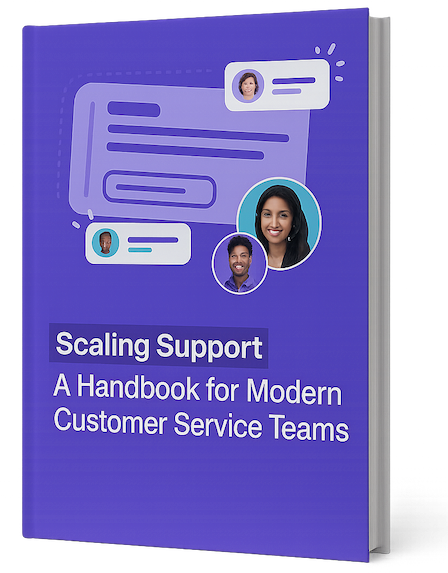Understanding the True Impact of Service Metrics

Service metrics are far more meaningful than simple statistics – they reveal how well your company builds and maintains customer relationships. When teams actively track and analyze these numbers, they can shift from just responding to problems to proactively building customer loyalty. Take First Response Time for example – monitoring how quickly your team first replies to customers helps identify delays and bottlenecks that need fixing.
Why Metrics Matter
In the past, many companies relied on customer feedback and instinct to gauge service quality. Today, data gives us a clearer picture. By tracking specific metrics, support teams can find exactly where they need to improve and show the concrete value they bring. Having clear goals and measurable progress also helps keep support staff motivated and engaged.
Key Metrics and Their Impact
A few essential metrics help paint the full picture of customer service effectiveness. Average Resolution Time (ART) measures how long it takes to fully solve customer issues – and faster solutions generally mean happier customers. To find your ART, add up all case resolution times and divide by total cases. For instance, if a team resolves 100 cases taking 500 total hours, the ART is 5 hours per case. This number spotlights where service processes need work. Learn more about calculating key metrics at How to Measure Customer Service Performance. Teams should also track Customer Satisfaction Score (CSAT) and Net Promoter Score (NPS) to understand customer happiness and loyalty.
Connecting Metrics to Business Outcomes
The real value of service metrics comes from linking them directly to business results. For example, when you lower the Customer Effort Score (CES) by making it easier for customers to get help, you often see them stay longer and buy more. Similarly, improving First Contact Resolution (FCR) can reduce costs while helping agents work more efficiently. By connecting specific metrics to business goals, teams create clear plans for improvement and can show how their work impacts the bottom line. This helps everyone see how support teams directly contribute to company growth and success.
Essential Metrics That Drive Service Excellence

The right metrics can help you understand what's happening in your customer service interactions and why. Here are the key performance indicators that indicate quality service and drive strong customer experiences.
Key Operational Metrics for Efficiency
Two essential metrics track how quickly and effectively your team handles customer inquiries. First Response Time (FRT) shows how fast you initially get back to customers – a quick first reply builds confidence, even if full resolution takes longer. Average Resolution Time (ART) measures total time to solve issues, calculated by dividing total resolution time by number of cases. Shorter ART often leads to happier customers and helps teams handle more requests.
Customer Satisfaction and Loyalty Metrics
Direct customer feedback provides critical insights into service quality. Customer Satisfaction Score (CSAT) captures ratings for specific interactions, highlighting what works and what needs work. For the bigger picture, Net Promoter Score (NPS) tracks customer loyalty and referral likelihood over time. Customer Effort Score (CES) evaluates how easily customers can get help – when this score is high, customers tend to stay longer and buy more.
Combining Metrics for a Holistic View
The best strategies balance speed and satisfaction metrics. For example, a team might close tickets quickly but get poor CSAT scores, suggesting they prioritize quantity over quality. On the flip side, great CSAT scores with slow resolution times may mean processes need streamlining. SupportMan helps teams find this balance by showing Intercom ratings in Slack alongside other key metrics, so teams can monitor both efficiency and quality in real-time.
Benchmarking and Continuous Improvement
Set meaningful targets for each metric based on your industry, past performance, and business goals. Regular reviews help spot trends and areas for improvement. By closely tracking these numbers and adjusting based on data, teams can get ahead of potential issues and keep making service better. Strong metrics guide the way to consistently excellent customer experiences.
Building Your Metrics Measurement Framework

A well-designed framework for measuring customer service performance is essential for making real improvements based on data. Just like building a house requires careful planning, creating your measurement system needs a clear structure for collecting and using information effectively.
Selecting the Right Tools and Metrics
Start by choosing metrics that directly connect to your business goals. If you want faster service, focus on tracking First Response Time (FRT) and Average Resolution Time (ART). For building customer loyalty, pay attention to Net Promoter Score (NPS) and Customer Satisfaction Score (CSAT). Tools like SupportMan make this easier by putting key measurements right into your daily workflow.
Establishing Reliable Data Collection
Good data comes from consistent measurement across all your customer service channels. For example, use the same survey format for CSAT scores and track resolution times the same way for every interaction. Think of it like following a recipe – you need to measure ingredients the same way each time to get reliable results.
Creating Actionable Dashboards
Raw numbers alone don't tell the full story. Build clear visual displays that show how different metrics relate to each other and change over time. For instance, seeing CSAT scores next to response times can reveal patterns and point to areas needing attention. Many teams find it helpful to share these dashboards through common tools like Slack, making it easy for everyone to stay informed and discuss the results.
Overcoming Implementation Challenges
Setting up a new measurement system often comes with some hurdles. You might face issues with data accuracy or team members who are unsure about the changes. Start by cleaning up your data – remove duplicates and fix any wrong information. Help your team understand how these measurements make their work better and more effective. Show them exactly how to use new tools and explain why each metric matters. With good planning and open communication, you can build a measurement system that helps your team improve and grow.
Using Predictive Analytics to Level Up Your Service

Most customer service metrics tell you what already happened. But predictive analytics, powered by AI and machine learning, helps you see what's coming next. This shift from reacting to problems to preventing them marks a real change in how leading companies deliver great service.
Spotting Customer Needs Early
By analyzing past customer data – from support tickets to purchase history to website behavior – predictive models can spot patterns that signal future needs. For instance, if someone keeps asking questions about a specific feature, the system can flag them as likely needing extra help with that feature. This allows support teams to reach out proactively with assistance before the customer gets frustrated.
Stopping Problems Before They Start
Teams can use predictive analytics to catch potential service issues early. The system analyzes data like call volumes, website traffic, and social media posts to forecast when you might see spikes in support needs. For example, if you're planning a big product launch, you can staff up ahead of time based on projected demand – keeping service smooth even during busy periods.
Smart Resource Planning
Getting the most from your support resources requires careful planning. Predictive analytics helps optimize everything from staffing levels to knowledge base content based on expected customer needs. This means better service at a lower cost. Teams can schedule more agents during predicted peak times to keep First Response Time (FRT) low. They can also create targeted self-help resources to improve Average Resolution Time (ART) by letting customers solve common issues on their own.
Making Predictive Analytics Work: Key Steps
Moving to predictive support takes careful planning. Focus on choosing the right tools, ensuring your data is clean and connected, and building strong partnerships between support teams and data experts. Tools like SupportMan can help by integrating these insights into platforms you already use, like Slack. This puts predictions right where your team works, so they can act quickly and keep refining their approach based on what works best.
Transforming Metrics Into Service Improvements
Numbers alone don't drive progress – it's about taking those measurements and creating real, meaningful change. While gathering customer service metrics lays the foundation, the key is turning that data into concrete improvements that benefit both customers and support teams. Let's explore how to move from analysis to action.
Identifying Opportunities for Improvement
Review your metrics carefully to spot meaningful patterns. For example, if your Average Resolution Time (ART) is higher than usual, it could signal the need for streamlined support processes or additional agent training. Similarly, when a high First Contact Resolution (FCR) rate coincides with low Customer Satisfaction Scores (CSAT), it may mean your team is closing tickets quickly but not fully addressing customer needs. SupportMan helps by making these metrics readily available in Slack, so teams can spot trends as they emerge.
Prioritizing Initiatives and Creating Action Plans
Focus on changes that will make the biggest difference with reasonable effort. If your Customer Effort Score (CES) shows customers struggle to get help, you might prioritize simplifying contact channels or improving self-service resources. Create clear, specific plans that outline who does what and when. For instance, to boost FCR, you could schedule knowledge base updates and plan targeted training sessions on common customer issues.
Measuring the Impact of Enhancements and Iterating
Keep a close eye on your metrics after implementing changes to see what's working. If your efforts aren't moving key numbers in the right direction, adjust your approach. For example, if knowledge base improvements haven't reduced ART, you might need to focus on making information easier to find through better search or organization. SupportMan's Slack integration makes it simple to share updated metrics and discuss needed changes with the team.
Fostering a Culture of Continuous Improvement
Making lasting improvements requires ongoing dedication, not one-time fixes. Build improvement into your team's DNA by regularly reviewing data together, celebrating wins, and openly discussing growth areas. Tools like SupportMan support this by putting key metrics directly in your team's daily workflow, encouraging open discussion about performance. When teams feel ownership over the improvement process, they're more likely to deliver consistently excellent customer experiences.
Emerging Trends in Service Performance Measurement
Today's businesses face new challenges in measuring customer service success. As customers connect through more channels and have higher expectations, companies need fresh approaches to track and improve their service quality. Let's explore the key developments shaping how businesses measure customer service performance.
The Rise of Omnichannel Measurement
Modern customers switch between multiple channels when getting help – they might start on social media, continue through email, and finish with a phone call. This makes omnichannel measurement essential for understanding the complete customer experience. Instead of looking at each channel separately, smart businesses track the full journey across all touchpoints. This helps spot where customers get stuck and shows how to make the entire experience smoother.
Beyond Satisfaction: Measuring Emotional Connection
While standard metrics like CSAT and NPS still matter, companies now focus more on the emotional bond between customers and brands. This means paying attention to how customers feel, not just what they say. Teams use tools to analyze sentiment in written feedback and detect emotions in voice calls. Understanding these emotional responses helps companies build stronger relationships rather than just solving problems.
Customer Effort: The New Efficiency Frontier
Research shows that making things easy for customers builds loyalty better than trying to exceed expectations. That's why Customer Effort Score (CES) has become such an important metric. When customers have to repeat information or jump through hoops to get help, it hurts their experience. By finding and fixing these friction points, companies can make their service more efficient and keep customers happier.
Preparing for the Future of Service Measurement
To stay competitive, businesses should focus on:
- Getting the right tools: Pick systems that can track customer interactions across channels, measure sentiment, and monitor customer effort
- Understanding the full journey: Map out how customers move between different channels when seeking help
- Training your team: Help support agents understand emotional intelligence and ways to reduce customer effort
Companies that adapt to these changes in service measurement will be better positioned to deliver the kind of experience that keeps customers coming back.
Need help tracking your customer service performance? SupportMan works with Slack to deliver real-time feedback and key metrics to your team. This helps you respond faster and constantly improve your service. Start your free trial today.



